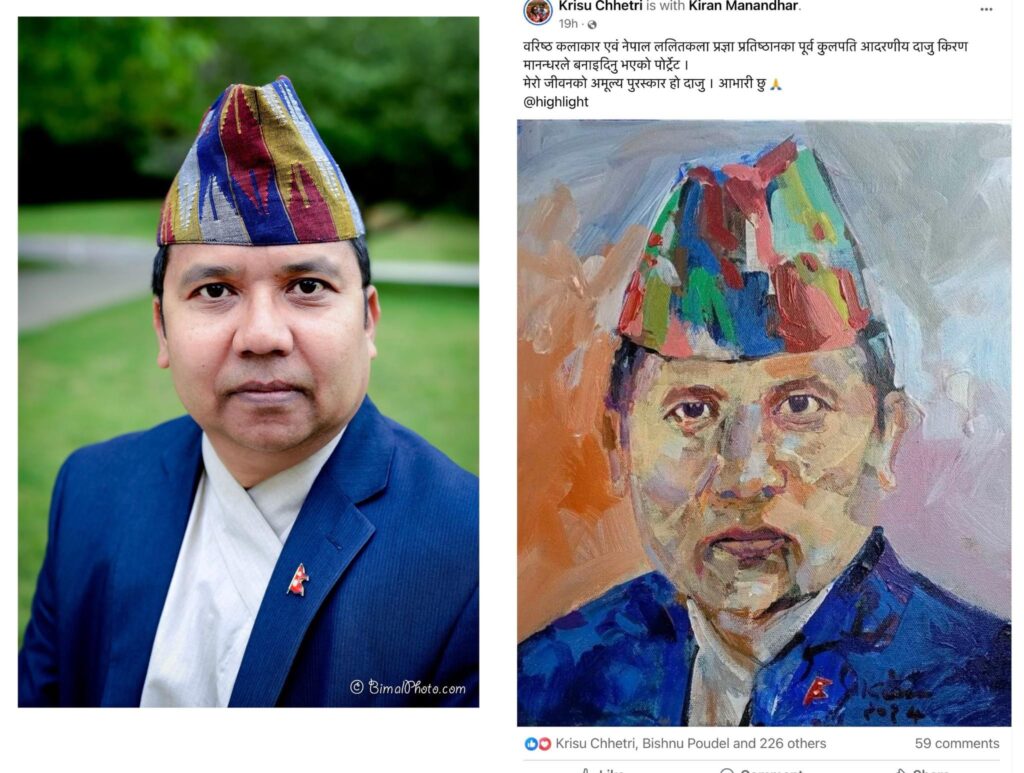As a professional photographer, my journey has allowed me to explore the power of images and the stories they tell. Recently, I encountered a situation that prompted me to reflect on important questions of ethics, copyright, and artistic integrity. While photographing Krisu Chhetri, a Nepali diplomat and contemporary poet representing Nepal in New York City, I created a professional portrait of him during his visit to Boston, MA. It was a proud moment to present him with the image for use on his social media, where I included my watermark and copyright symbol. To my delight, he greatly appreciated it.
However, I was recently surprised to discover that the renowned Nepali artist Kiran Manandhar, a former Vice Chancellor of the Nepal Art Academy, had taken my photograph and turned it into an oil (or possibly acrylic) painting. Although I am not entirely certain of the medium, I’ll leave it to the audience and art critics to decide whether it’s a direct copy.

The painting closely resembles my original photograph, with identical colors, lighting, pose, and traditional Nepali clothing. The artist signed his name on the canvas, and upon comparing the two side by side, it became almost certain to me that the painting was a direct copy of my work.
While I don’t wish to sound disrespectful, this situation raises genuine concerns about ethics, copyright law, and common practices in the art world. As I reflect on this, I would like to engage the broader Nepali art community, as well as anyone interested in the intersection of photography and painting, in a discussion about these important issues.
Copyright: Who Owns What?
In this case, the first question is one of ownership. Copyright law is clear: as the photographer, I hold the copyright to the image I created. Photographs are automatically protected under copyright from the moment they are taken. Unless I explicitly licensed my work to the painter or waived my rights, the image remains my intellectual property. When a painting is made based on a photograph, it typically qualifies as a “derivative work”—a creation that builds upon or is based on an existing copyrighted work. Creating a derivative work requires permission from the original copyright holder, which, in this case, is me.
Beyond the legal aspect, this also becomes an issue of respect for the original artist. Copyright is not only about protection but also about crediting the creative effort behind a work.
The Ethics of Attribution and Consent
Ethics in the art world hinge on proper attribution and consent. Ideally, before creating a painting based on someone else’s photograph, a painter would seek permission from the photographer and ensure proper credit is given. It is important to acknowledge the contribution of the original artist, especially when the artwork is an almost exact replica.
In the case of Kiran Manandhar’s painting, while I am flattered that he found my photograph worthy of replication, the absence of permission or credit is concerning. Copying another artist’s work without acknowledgment undermines the creative process and devalues original contributions. Ethical practice demands transparency, and I believe these situations present valuable teaching moments for artists across all mediums.
Common Practices in the Art World
In some cases, collaborations between photographers and painters occur, with proper agreements in place regarding credit and profit-sharing. When a painter wants to use a photograph as a reference for their painting, the photographer often licenses the image, establishing terms that protect both parties.
There are also artistic traditions of recreating iconic works in different styles or mediums as tributes, homages, or educational pieces. However, in most of these instances, the original creator is credited, and the work is identified as a recreation. Failing to do so, especially when the replication is nearly identical, can lead to both ethical and legal disputes.
International Cases That Reflect This Issue
This is not the first time the art world has faced such questions. Some well-known examples include:
• Richard Prince’s Case: In 2015, Richard Prince, a controversial figure in the art world, faced legal action after using other artists’ Instagram photos without permission. While he argued that his use was transformative, the case reignited debates about the limits of artistic appropriation and intellectual property.
• Shepard Fairey’s Obama “Hope” Poster: Shepard Fairey created the famous “Hope” poster using a photograph of then-presidential candidate Barack Obama taken by Associated Press photographer Mannie Garcia. Fairey’s use of the photograph without permission led to a lawsuit that was eventually settled out of court, highlighting the complexities involved in reusing photographs in different mediums.
Both cases underscore the importance of understanding the boundaries of creativity and respecting the work of other artists.
What Now? A Call for Conversation and Ethical Practice
This situation presents an opportunity for reflection and dialogue within the Nepali art community, as well as the broader global audience. As someone who deeply values artistic expression, I am not seeking conflict, but rather a thoughtful conversation about the ethical and legal implications of using other people’s work without permission.
While I am proud of the photograph I took of Krisu Chhetri, it is crucial that, as artists—whether photographers, painters, or creators in any other medium—we respect one another’s creative work. The rights of creators should not be overlooked or bypassed simply because the work has been transformed into a new medium. A painting derived from a photograph should still acknowledge its source.
How I Plan to Address This Issue
For fellow artists and followers, I encourage you to join me in raising awareness about the importance of crediting original creators. Here’s how I plan to engage on this topic through social media:
• Transparency: I will calmly explain the situation without personal attacks. I believe in fostering an open discussion about artistic rights and responsibilities.
“Recently, an oil painting was created based on one of my original photographs. While I’m honored by the recognition of my work, I think it’s essential to discuss the importance of proper attribution and intellectual property in art.”
• Engage in Discussion: Art is about conversation, so I’ll invite my followers to share their thoughts:
“What do you think about the ethical and legal aspects of using someone else’s work as a reference? Let’s explore the fine line between inspiration and appropriation together.”
• Stay Professional: I’ll contact the artist involved and have a constructive discussion about properly crediting my work. This helps maintain professionalism and opens the door to a resolution.
• Educate My Audience: I want to use this opportunity to spread awareness about copyright laws and ethical practices:
“For my fellow creatives: Did you know that photographs are protected by copyright law, even if recreated in another medium? Always seek permission and give credit where it’s due!”
As artists, we rely on one another for inspiration and support, but we must also ensure that we respect each other’s rights and intellectual property. By raising these questions, I hope to contribute to a culture of mutual respect in the art world, both in Nepal and globally.
I invite you all to reflect on these issues and join the conversation. Together, we can foster a more ethical and respectful creative environment for everyone.
[Bimal Nepal is a professional photographer based in Austin, Texas, known for his exceptional ability to capture compelling images that tell powerful stories]













